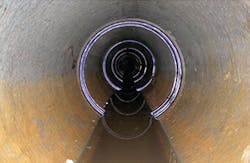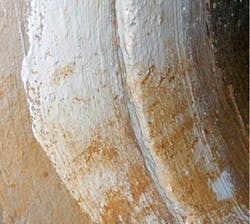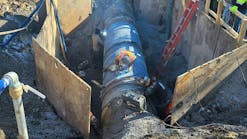CLIENTS USUALLY CALL HYDRATECH to repair aging pipes. This time, the pipe causing headaches was brand new.
After installing a 36-inch-diameter, 3,700-foot-long reinforced concrete sewer line segment, an Ohio River Valley municipality found to their horror that it was leaking…all down the line. Perfunctory testing showed that every one of the pipe’s 473 joints was leaking. The cause was improper installation. It would be irresponsible to put the line into service with so much infiltration and inflow of water, but the sewer was urgently needed. The municipality needed a solution.
They considered several options for repairing the sewer segment. These included lining the entire length of pipe and ripping the pipe out entirely. Both ideas were expensive and overkill; the pipe was new, the trench was already filled, and the infiltration and inflow were only happening at the joints. The municipality also discussed—and dismissed—the idea of using chemical grout.
A FASTER, CHEAPER, LESS-DISRUPTIVE SOLUTION
A Louisville firm that had frequently provided sewer inspection and testing for the city—Robinson Pipe Cleaning Company—had a more efficient suggestion. Robinson recommended HydraTech Engineered Products’ HydraTite Internal Joint Seal. Considering lead times, costs, and job duration, the municipality decided to go with this trenchless, all-mechanical fix.
HydraTite, known as “The Seal That Seals From The Inside Out,” is used to repair leaking pipes without the disruption of excavation. Often used for emergency repairs, it is a proven solution for joint leaks that has been employed over 30,000 times in North America alone. The system consists of a customized rubber seal held in place by stainless steel retaining bands. HydraTite utilizes a ribbed design to ensure a watertight seal and is a pipe joint repair method recognized by the America Water Works Association’s M28. Each seal is made in the US and manufactured in one piece to match the diameter of the client’s pipe.
The sealing system for this Ohio Valley job needed to meet the expected head pressure of a 100-year flood. HydraTech solved this problem by engineering the standard system with an extra reinforcing steel band.
JOINING FORCES TO SEAL THE JOINTS IN RECORD TIME
Because the job was so large, and the municipality had such an aggressive schedule for the seals to be fabricated and installed (all 473 seals were to be installed in just six weeks), HydraTech and Robinson decided to join forces. HydraTech manufactured the seals while providing installation training and certification for Robinson’s staff. After the city approved the team’s repair plan, it was time for installation to begin.
Each seal took about 40 minutes to install using a systematic process: First, the rubber seal was laid into the joint. Then, the first stainless steel retaining band was locked into place with a hydraulic expander, utilizing the HydraTech wedge-lock system. The second steel band was then added, along with the valve pressure tester.
After the final seal was installed, the client and repair team held their collective breath while each joint was air-pressure tested using the HydraTech valve (that works like a “soap bubble test” to see if air is getting into the pipe joints). There were no leaks! The HydraTech-Robinson team had completed the job on time and the municipality was able to put the repaired line into service more quickly and affordably than they had dared hope.
SIMPLE INSTALLATION, LONG SERVICE LIFE
One of the Robinson installers summed up the process like this: “Installation was extremely simple and made it easy to meet production numbers. The training staff was very helpful and great to work with on this project. The onsite inspector was blown away during the low-pressure air test because the pressure didn’t drop at all!”





